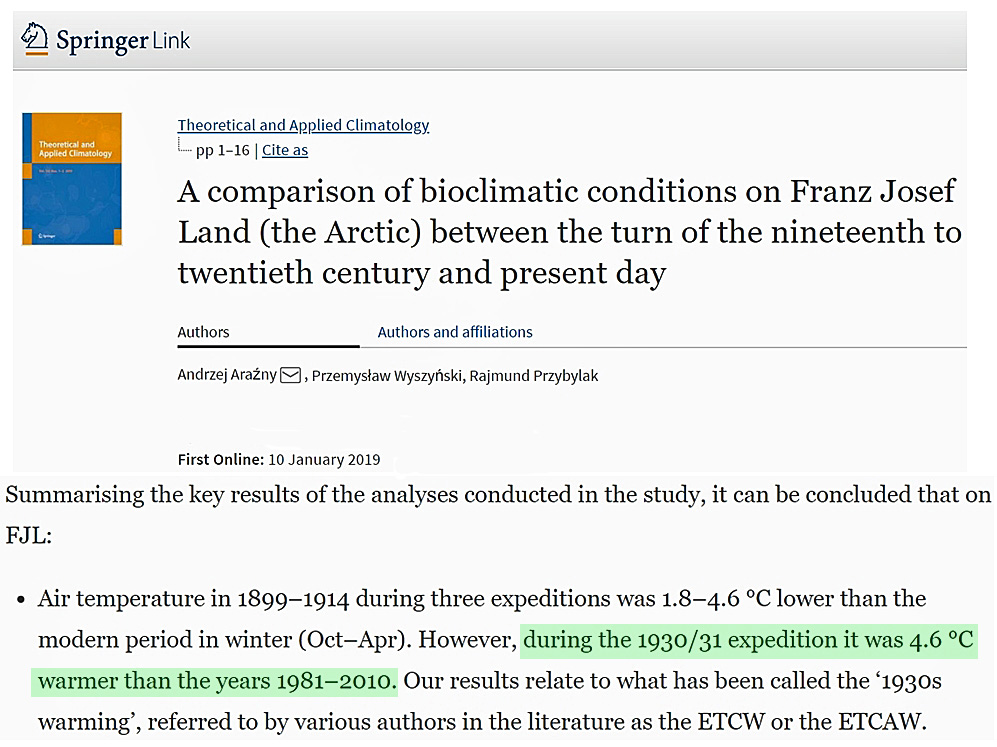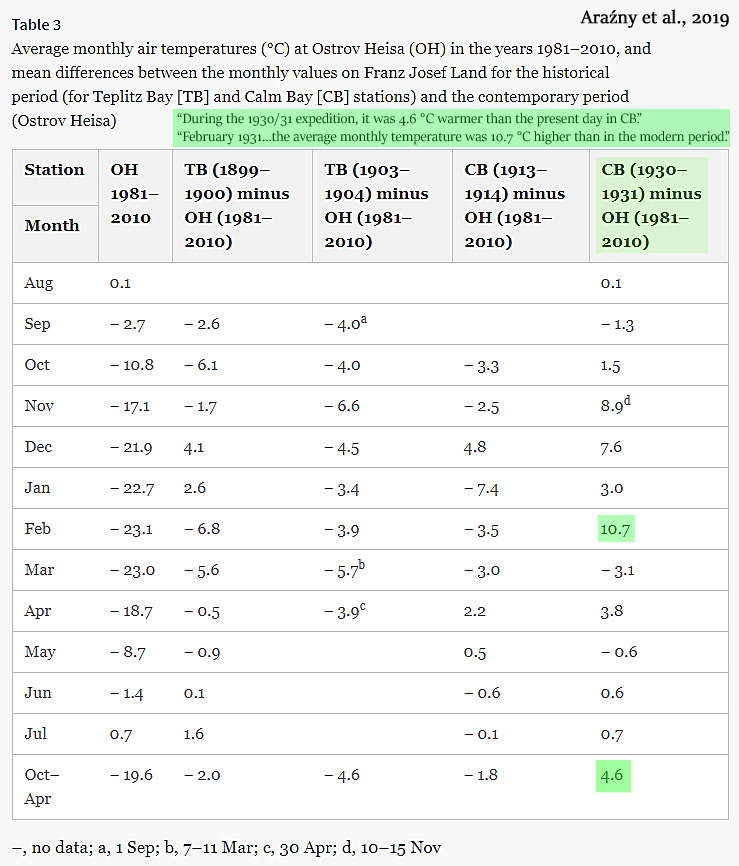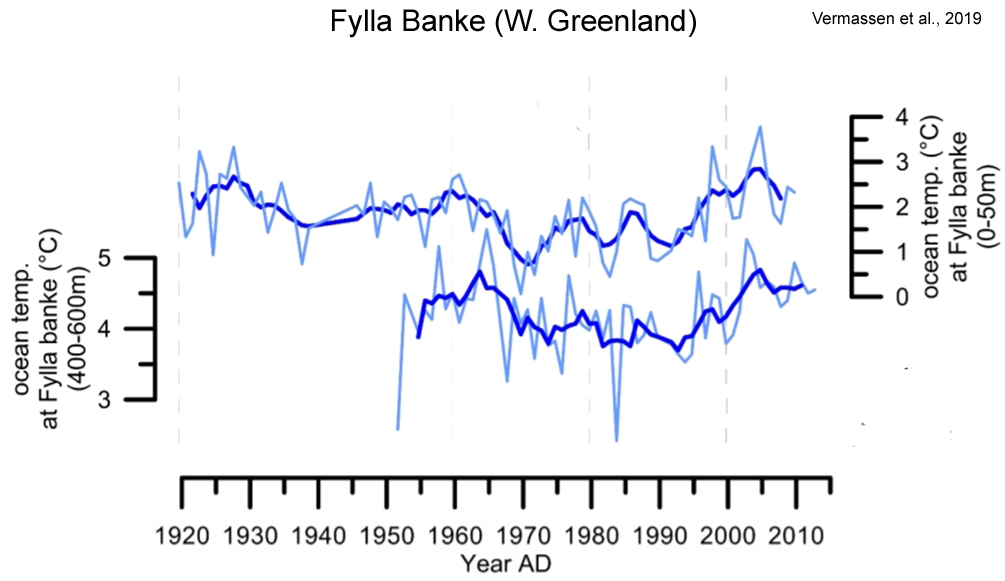Yet another scientific paper presents evidence that the Arctic region was warmer than recent decades during the 1930s, leading scientists to conclude there is “still-insufficient knowledge of the mechanisms governing the Arctic Climate System.”

Image Source: Araźny et al., 2019
Araźny et al., 2019
A comparison of bioclimatic conditions on
Franz Josef Land (the Arctic) between the
turn of the 19th to 20th century and present day
“Air temperature in 1899–1914 during three expeditions was 1.8–4.6 °C lower than the modern period in winter (Oct–Apr). However, during the 1930/31 expedition it was 4.6 °C warmer than the years 1981–2010. Our results relate to what has been called the ‘1930s warming’, referred to by various authors in the literature as the ETCW or the ETCAW.”
“In individual months, the highest negative anomalies were identified in Calm Bay (hereafter CB) in January 1914 (− 7.4 °C) and in February 1900 (− 6.8 °C). In contrast, during the 1930/31 expedition, it was 4.6 °C warmer than the present day in CB [Calm Bay]. Such a high thermal anomaly was influenced by a warm autumn and winter, especially February 1931, when the average monthly temperature was 10.7 °C higher than in the modern period.”
“In approximately the last 140 years, there have been two periods of significant temperature increases in the Arctic. The first began in around 1918–1920 and lasted until 1938 and has been called the ‘1930s warming’ (Bengtsson et al. 2004). Other works have referred to this period as the ‘Early Twentieth Century Warming’ (ETCW, Brönnimann 2009) or the ‘Early Twentieth Century Arctic Warming’ (ETCAW, Wegmann et al. 2017, 2018). Our results confirm the observations for the last expedition from the historical study period in 1930/1931. These years covered the warmest part of the ETCW. In turn, the second increased warming of the Arctic began around 1980 (Johannessen et al. 2004) or according to Przybylak (2007) in about the mid-1990s. Changes in overall atmospheric circulation have long been believed to have been the cause of the ETCW (e.g. Scherhag 1937). As the modern climate warming (since 1975) has progressed in a largely similar manner to the progression of the ETCW (Wood and Overland 2010; Semenov and Latif 2012), there has been renewed interest in the insufficiently well-explained causes of the ETCW using the latest research methods, including, primarily, climate models. An analysis of the literature shows that the cause of such a significant warming in the present period is still not clear. There is even controversy over whether the main factors in the process are natural or anthropogenic, although the decided majority of researchers assign a greater role to natural factors (Bengtsson et al. 2004; Semenov and Latif 2012). It would appear that the greatest differences of opinion on the causes of the ETCW are to be found in works presenting climate models (see, e.g. Shiogama et al. 2006; Suo et al. 2013), which is an excellent illustration of the still-insufficient knowledge of the mechanisms governing the Arctic Climate System.”

Image Source: Araźny et al., 2019
Another new paper indicates that West Greenland retreat rates were much higher “(400-800 m/yr)” during the 1930s and 1940s than “after 2000 (>200 m/yr)”.
Vermassen et al., 2019
A reconstruction of warm water inflow to Upernavik Isstrøm
since AD 1925 and its relation to glacier retreat
“A link between the physical oceanography of West Greenland and Atlantic SSTs has indeed been suggested previously: a positive phase of the AMO [Atlantic Multidecadal Oscillation] is related to an increase of warm Atlantic waters flowing towards and along the SE and W Greenland shelf (Drinkwater et al., 2014; Lloyd et al., 2011). Our data indeed supports that the AMO influences bottom water temperature variability along the West Greenland shelf and shows that this influence is strong within Upernavik Fjord.
“Despite differences in the timing and magnitude of the retreat of the different glaciers, they broadly share the same retreat history. High retreat rates occurred between the mid ‘30s and mid ‘40s (400-800 m/yr), moderate retreat rates between 1965-1985 (~200 m/yr, except for Upernavik) and high retreat rates again after 2000 (>200 m/yr).”
“[O]ur study shows that while warming of ocean waters in Upernavik fjord likely contributed to the retreat phases during the 1930s and early 2000s, ocean warming is not a prerequisite for retreat of Upernavik Isstrøm.”
“This is important since it implies that the future potential oceanic forcing of Upernavik Isstrøm will depend on changes related to circulation in the North Atlantic (i.e. the AMO). Since the meridional overturning circulation strength and associated heat transport is currently declining, (Frajka-Williams et al., 2017), this may lead to cooling bottom waters during the next decade in Upernavik Fjord and most likely also other fjords in West-Greenland.”






Attn readers: Users no longer have to be registered and logged in to comment. I’ve installed a new spam filter, and so I hope this will take care of the problem.
“Since the meridional overturning circulation strength and associated heat transport is currently declining, (Frajka-Williams et al., 2017), this may lead to cooling bottom waters during the next decade in Upernavik Fjord and most likely also other fjords in West-Greenland.””
Well, I guess that gives us something to keep an eye on.
P.S., Thanks, Pierre.
“It would appear that the greatest differences of opinion on the causes of the ETCW are to be found in works presenting climate models (see, e.g. Shiogama et al. 2006; Suo et al. 2013), which is an excellent illustration of the still-insufficient knowledge of the mechanisms governing the Arctic Climate System. ”
So this planet appears by this analysis to have been warmer during the 1930s, not really a surprise is it. And certainly the CO2 warming can not be to blame as it was by the IPCC faulty ideas within safe limits. And the Arctic Climate System’s does not seem to be governed by the mythical CO2 warming either.
Like so many other academic papers these paper show that the mythical CO2 warming is just that — mythical. CO2 does not, and never has driven the climate, only hateful (of humans), fear-mongering cAGW zealots assert such anti-science nonsense.
Those who can read, are surprised that you equate the Arctic with the whole planet. We are not surprised however that you’d jump to a conclusion like that.
Same as the temperature within your home is “not governed” by your central heating system either. Nevertheless, the added heat gets distributed throughout your home … very mythical indeed.
Says the person who claims the globe has been warming when large regions of the ocean and land have been cooling in recent decades.
Similarly, Greenland and the Arctic and Antarctica have not warmed in the last 80-100 years. The Pacific and Southern Ocean cooled since the 1970s. Europe hasn’t warmed since the 1930s.
Antarctica is probably a perfect example. 2/3rds of the continent cooled from the early 1900s to the early 2000s. About 1/4th of the continent warmed (though the Peninsula has been rapidly cooling since 2000). But because the net change was +0.2°C, that counts as evidence of “global” warming. Similarly, the parts of the ocean that are cooling have been slightly superseded by the parts that are warming. Nonetheless, you call this “global” warming anyway. After all, the oceans have warmed by “only 0.1°C” in the last 50 years. So…it’s CO2.
When the Earth was 4-6°C warmer than today back when CO2 levels hovered around 255 ppm, there likely were regions that weren’t quite as warm as other regions.
Kenneth,
Do you need a refresh what globe or global means? Also what cooling? All ocean basins are going up heat content wise.
Is that one of those instances where you take one datapoint of the past and compare it to one datapoint today, determine that they are roughly the same and then conclude nothing has happened? 😉
If that is proper (climate) science then let me show you how cloud cover never changed in graphs like this one: https://www.climate4you.com/images/CloudCoverTotalObservationsSince1983.gif
Yes, that’s how math works. When talking about global changes we don’t care if 99.9% went in one direction and 0.1% went in the other direction. If the later change is bigger than the first, this is what is happening globally.
Write it down as Joules and you’ve got yourself an amount that corresponds to the CO2 forcing. So, yeah … can be attributed to CO2. If it isn’t CO2, then that forcing goes somewhere else. Where?
So? Temperature isn’t uniform and can change without CO2 levels changing. How does that change that it’s CO2 today? And that the total heat content of this planet (at least near the surface) is increasing?
No, they’re not all going up: https://pbs.twimg.com/media/D1KV1gVX4AApwAK.jpg
So SebastianH, the Arctic is not part of the world?
What a strange imaginary world you live in.
Those who can read might notice Sebastian said:
“Those who can read, are surprised that you equate the Arctic with the whole planet.”
and previously said:
“One more time. Warming at the poles comes from heat transfer from lower latitudes.”
https://notrickszone.com/2018/04/16/in-2015-climate-scientists-wrecked-their-own-co2-forced-polar-amplification-narrative/
Yes, when it’s pointed out that polar CO2 forcing is, at most, 0-1 W m-2 for Antarctica and “comparatively weak” for Greenland (which is not enough to melt ice sheets), he says that the poles are controlled by CO2 via oceanic heat transport from lower latitudes.
Indeed, consistency is not one of Sebastian’s strongest attributes.
Indeed pmc47025,
I was hoping to move in that direction, ho-humm. …
Al Gore predicted the Arctic sea ice would be gone by 2013. Obviously this didn’t happen. SebastianH is notrickszone’s bargain basement version of Al Gore and like Gore he’s become less and less pertinent as cAGW’s climate gloom and doom fails to pan out. SebastianH has yet to understand and appreciate that it’s nature still running the climate show and not human generated CO2.
All SebastianH has left is to rage against what gets written here, and profess with no evidence what’s so ever, that he can show that a very rare atmospheric CO2 gas drives the climate or some such nonsense.
The vast number of people who live in North & NCentral USA (or even California) have found out how much CO2 keep the atmosphere warm as the Arctic blast bringing snow and polar winds have piled in for months. Was there no CO2 in those winds? 🙂
Check out figure 2 of this Levitus et al 2009 paper:
https://agupubs.onlinelibrary.wiley.com/doi/pdf/10.1029/2009GL039847
shows that the top 150m water temperature of the Barents Sea is closely correlated with the AMO. This confirms that the AMO is associated with an oscillating in the strength of warm water transport into the Arctic.
No Phil, it’s of course volcanoes, just believe your fellow climate skeptics 😉
http://www.plateclimatology.com/arctic-ocean-hot-spots-generated-by-sea-flor-geological-heat-flow-not-climate-change
Or is it just less ice imports?
https://www.nature.com/articles/s41558-018-0205-y
Sebastian
Or better yet
If it’s a competition for stupid
The dumb, dumber and dumbest prize goes to …
IT’S CARBON DIOXIDE!!!
SebH has no more integrity than any of the crooked pseudo-scientists he supports. Willy Soon exposes them here. Thugs, bullies, manipulative sociopaths? So it would appear; Objective and honest scientists? Not so much.
https://youtu.be/aYAy871w9t8
SebH will deny it, naturally. But he is no more trustworthy than they are, as anyone who has been reading his material here is nauseously well aware.
[…] a new study finds that the Arctic region was 4.6 degrees Celsius warmer in the 1930s than in recent years. And […]
[…] a new study finds that the Arctic region was 4.6 degrees Celsius warmer in the 1930s than in recent years. And […]
[…] a new study finds that the Arctic region was 4.6 degrees Celsius warmer in the 1930s than in recent years. And […]
Interesting that ship data illustrates that Arctic ice conditions back in the 19th century were similar to today.
https://seagrant.uaf.edu/nosb/2005/resources/arctic-explorers.pdf
Some winters can be worse than others.
“In North America, the winter of 1784 was the longest and one of the coldest on record. It was the longest period of below-zero temperature in New England, the largest accumulation of snow in New Jersey, and the longest freezing over of Chesapeake Bay. There was ice skating in Charleston Harbour, a huge snowstorm hit the south, the Mississippi River froze at New Orleans, and there was ice in the Gulf of Mexico.”
<a href-"http://www.climate4you.com/ClimateAndHistory.htm#General%C2%A0"<climate4you
Sounds cold to me, Little Ice Age in its finest days.
The Laki eruption in Iceland was to blame for the bad winter.
Everybody talks about the climate, studies it until the cows come home, and everybody is doing something to do something about climate change, what, I don’t know, but they’re doing it. lol
There is a small lake about thirty miles from where I am, during the Dust Bowl years of the 1930s, it was dry. Today it is full of water, pelicans live there during the summer months, the fishing must be good.
There was no water in the lake, you could walk across the dry lake bed to the other side. Dust Bowl, riverbeds dry up when there is no water. Go to Wyoming and see for yourself how it happens. Water is a limiting factor.
The record temp in my state was set during the 1930s. Both low and high, in the same county in the same year.
When it is dry, there will be no crop. None. Nothing there at all. Cattle herds are sold off, farmers and ranchers have to live through miserable conditions when everything dries up.
Too much water can be worse than drought conditions. No crop then either, it feels worse than no water when too much is there. Too much accumulated snow, too much precipitation, do cause overland flooding, you can’t even plant a crop, there is water out in the fields, not land. When lakes increase in size, you lose farmland, what was cropland is now covered by water. Farmsteads are surrounded by water that doesn’t go away. You have to abandon what you have, you can’t live there. It happens and does in the now. A river 100 feet wide will become a moving lake two to three miles wide. I’ve seen it happen. You’re surrounded by water. You’ll be moving, you will be forced out of your house and home. A climate change refugee. That’s the way it goes moving west.
This winter is proving to be colder than normal, temps refuse to rise to above freezing, stay below zero at night and the cold doesn’t stop. Once the ground has been thirty below zero for a few nights, it is difficult for anything to warm up.
The forecast was for a warmer winter, but that was just wishful thinking. Feels more like an ice age out there more than it feels like a summer day, let me tell ya.
Another winter storm is on the way to dump another pile of snow on top of what is there and the potential for flooding has increased substantially in some areas.
Fourteen more days of winter, then it is history, Old Man Winter ain’t lettin’ up any.
This is in my bookmarks:
https://archive.org/details/glaciervariation00ahlm/page/22
A study of Arctic glaciers well worth reading with detailed temperature graphs.
[…] a new study finds that the Arctic region was 4.6 degrees Celsius warmer in the 1930s than in recent years. And […]
[…] https://notrickszone.com/2019/03/07/new-study-reveals-the-arctic-region-was-4-6c-warmer-than-recent-d… […]
[…] https://notrickszone.com/2019/03/07/new-study-reveals-the-arctic-region-was-4-6c-warmer-than-recent-d… […]